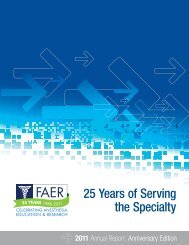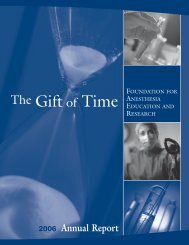2010 MSARF Symposium Participants - Foundation for Anesthesia ...
2010 MSARF Symposium Participants - Foundation for Anesthesia ...
2010 MSARF Symposium Participants - Foundation for Anesthesia ...
Create successful ePaper yourself
Turn your PDF publications into a flip-book with our unique Google optimized e-Paper software.
Thus colloids guarantee better hemodynamic stability as well as better perfusion and tissue oxygenation. In a large multicenter<br />
study we are currently assessing the effect of goal directed crystalloid (lactated Ringer) and colloid (HES 130/0.4)<br />
administration on 30-day morbidity. As a component of this study, we assessed the effect of colloid versus crystalloid<br />
administration on time-weighted average (TWA) of intraoperative corrected flow time, cardiac output, and stroke volume<br />
in the first 38 patients enrolled at the Cleveland Clinic. We used student t test or Wilcoxon rank sum test, as appropriate.<br />
The observed medians of the total amounts of colloid and crystalloid were 0.9 [Q1, Q3: 0.5, 1.1] L and 1.6 [1.0, 1.9] L in<br />
the colloid group, and 0 [0, 0] L and 2.9 [1.9, 6.1] L in the crystalloid group, respectively. No difference was observed<br />
between the colloid and the crystalloid groups on the TWA of corrected flow time (median [Q1, Q3]: 366 [352, 407] vs.<br />
360 [338, 376] ms; P = 0.16), TWA of cardiac output (mean ± SD: 5.7 ± 1.1 vs. 5.7 ± 1.2 L; P > 0.99), or TWA of stroke<br />
volume (71.6 ± 8.8 vs. 74.6 ± 17.5 mL; P = 0.54). In summary, hemodynamic parameters were comparable in both<br />
groups.<br />
Student Name: Christa Schueller<br />
Host Department: Regents of the University of Michigan<br />
Primary Mentor Name: Chad Brummett, MD<br />
Additional Mentors: Amy Shanks MS, Brian Hallstrom, MD, Andrew Urquhart MD, Daniel J. Clauw MD<br />
Title of Research Project: The Impact of Comorbid Fibromyalgia on Acute Postoperative Pain and Perioperative<br />
Opioid Consumption in the Lower Extremity Joint Arthroplasty Population<br />
Purpose: This study was designed to study the hypothesis that patients with comorbid fibromyalgia undergoing total knee<br />
and hip arthroplasty (TKA and THA) would describe more acute postoperative pain as measured by pain scores and<br />
opioid consumption.<br />
Methods: This is a secondary analysis of patients prospectively recruited into a study investigating the chronic pain<br />
outcomes of TKA and THA. The American College of Rheumatology (ACR) fibromyalgia survey was used to calculate a<br />
fibromyalgianess score (0-31). Fibromyalgia (FM+) was classified as >= 13. Perioperative opioid consumption was<br />
analyzed in relationship to fibromyalgianess using non-parametric tests (alpha =0.05).<br />
Results: The mean fibromyalgianess score was 7 (+/-4), with 24 of the 311 patients defined as FM+ (7.7%). There were a<br />
higher proportion of female patients in the FM+ group (70.8% vs 50.9%, p = 0.06).<br />
There were no differences between the groups in the use of regional anesthesia or intraoperative opioid dosing. FM+<br />
received significantly more opioids in the PACU (median [IQR] FM+ 10 [0-20] vs. FM- 4 [0-10] mg IV morphine<br />
equivalents [IVME], p = 0.034) and <strong>for</strong> the remainder of their inpatient course (FM+ 74.1 [42.5-117.2] vs. FM- 50 [28.5-<br />
72.5] mg IVME, p = 0.005). FM+ reported higher pain scores in the PACU (FM+ 8 [5-10] vs. FM- 6 [3-9], p = 0.024).<br />
Discussion: This is the first study to demonstrate that comorbid fibromyalgia impacts perioperative pain and opioid<br />
consumption. Given the known neurophysiologic alterations in fibromyalgia, future studies should consider alternative<br />
treatments, such as gabapentinoids and/or serotonin-norepinephrine reuptake inhibitors.<br />
Student Name: Chirag Shah<br />
Host Department: University of Colorado Denver<br />
Primary Mentor Name: Ana Fernandez-Bustamante, MD, PhD<br />
Title of Research Project: Effect of obesity on ICU admission after prolonged abdominal surgery<br />
Introduction: To determine the effect of obesity on the incidence of postoperative ICU admission.<br />
Methods: We per<strong>for</strong>med a retrospective cross-sectional study in our electronic database including all adult patients<br />
undergoing elective abdominal surgery of >=4h duration during a 3 year period. Demographic, preoperative<br />
(comorbidities), intraoperative (i.e. ventilatory settings, fluid administration) and postoperative (outcomes) in<strong>for</strong>mation<br />
was collected and analyzed. Patients were classified based on their Body Mass Index (BMI) as “obese” (BMI>=30) and<br />
“non-obese” (BMI





